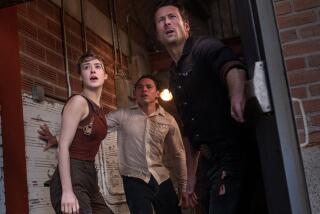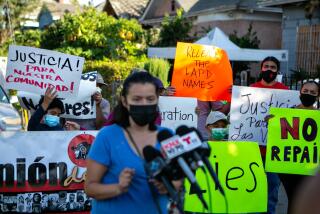‘Twilight’ Jury Will Visit Movie Set Scene of Fatal Accident
- Share via
Jurors will be allowed to visit the site of the fatal “Twilight Zone” helicopter accident, but will not see special effects bombs exploded at the former movie set, a Superior Court judge ruled Thursday.
Judge Roger W. Boren said he believes that the panel should visit the site to better understand spatial relationships that are not accurately shown on diagrams and three-dimensional models that have been presented in court during the involuntary manslaughter trial of director John Landis and four film-making associates.
Boren said his visit to Indian Dunes Motorcycle Park near Saugus on Wednesday helped him understand better the size of the area. A mock Vietnam village had been constructed at the site in 1982 during the filming of “Twilight Zone: The Movie.”
But the judge refused to allow Deputy Dist. Atty. Lea Purwin D’Agostino to arrange a special effects demonstration in which bombs similar to the ones used in the filming would be exploded for the jury’s benefit.
Earlier in the day, and FBI agent testified that the ill-fated helicopter barely moved when three initial explosions went off, but went into a tailspin shortly after the third blast.
Gerald Richards, an expert in photographic analysis, showed jurors charts he constructed from a frame-by-frame analysis of movie film that recorded the fatal scene.
Richards was called to the stand to give the most exact approximation so far of the helicopter’s location when special effects explosions knocked it out of the sky.
The helicopter, filming part of a Vietnam War scene on July 23, 1982, careened out of control and fell onto actor Vic Morrow, 53, and two children, killing them.
A key portion of Richards’ testimony involved an evaluation of whether debris thrown up by the explosions caused the crash.
The debris theory is a key factor in the trial of Landis, associate producer George Folsey, production manager Dan Allingham, special effects coordinator Paul Stewart and pilot Dorcey Wingo.
The prosecution claims that flying debris was a well-known danger that could have been prevented.
The defense asserts that heat delamination of a helicopter blade, a process by which the aluminum skin separates, caused the crash. They contend that such a chemical reaction was unprecedented and could not have been foreseen.
Richards, using charts to show how he analyzed pictures of the crash, said, “The helicopter stayed in a stationary position through the first three explosions. It didn’t move virtually at all.”
As it hovered, he said, the helicopter skids were about 24 to 25 feet off the ground.
“Just after bomb three, the helicopter started rotating north, counterclockwise,” he said.
The movement continued as two more bombs went off, and then, as more explosions followed, the helicopter reversed direction and spun clockwise until it fell on the actors, he said.
More to Read
Only good movies
Get the Indie Focus newsletter, Mark Olsen's weekly guide to the world of cinema.
You may occasionally receive promotional content from the Los Angeles Times.










